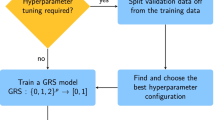Abstract
It is widely agreed that complex diseases are typically caused by the joint effects of multiple instead of a single genetic variation. These genetic variations may show very little effect individually but strong effect if they occur jointly, a phenomenon known as epistasis or multilocus interaction. In this work, we explore the applicability of decision trees to this problem. A case-control study was performed, composed of 164 controls and 94 cases with 32 SNPs available from the BRCA1, BRCA2 and TP53 genes. There was also information about tobacco and alcohol consumption. We used a Decision Tree to find a group with high-susceptibility of suffering from breast cancer. Our goal was to find one or more leaves with a high percentage of cases and small percentage of controls. To statistically validate the association found, permutation tests were used. We found a high-risk breast cancer group composed of 13 cases and only 1 control, with a Fisher Exact Test value of 9.7×10− 6. After running 10000 permutation tests we obtained a p-value of 0.017. These results show that it is possible to find statistically significant associations with breast cancer by deriving a decision tree and selecting the best leaf.
Access this chapter
Tax calculation will be finalised at checkout
Purchases are for personal use only
Preview
Unable to display preview. Download preview PDF.
Similar content being viewed by others
References
Breiman, L., Friedman, J., Olshen, R., Stone, C.: Classification and regression trees. Wadsworth, Belmont (1984)
Cho, Y.M., Ritchie, M.D., Moore, J.H., Park, J.Y., Lee, K.U., Shin, H.D., Lee, H.K., Park, K.S.: Multifactor-dimensionality reduction shows a two-locus interaction associated with Type 2 diabetes mellitus. Diabetologia 47(3), 549–554 (2004)
Cordell, H.J.: Epistasis: what it means, what it doesn’t mean, and statistical methods to detect it in humans. Human Molecular Genetics 11(20), 2463–2468 (2002)
Duda, R., Hart, P.: Pattern Classification and Scene Analysis. Wiley, New York (1973)
Griffiths, A.J.F., Wessler, S.R., Lewontin, R.C., Gelbart, W.M., Suzuki, D.T., Miller, J.H.: Introduction to Genetic Analysis. W.H. Freeman and Co Ltd., New York (2008)
Hancock, T.R., Jiang, T., Li, M., Tromp, J.: Lower bounds on learning decision lists and trees. Inform. Comput. 126(2), 114–122 (1996)
Hardy, J., Singleton, A.: Genomewide association studies and human disease. New England Journal of Medicine 360(17), 1759–1768 (2009)
Hyafil, L., Rivest, R.L.: Constructing optimal binary decision trees is np-complete. Inform. Process. Lett. 5(1), 15–17 (1976)
Knijnenburg, T.A., Wessels, L.F., Reinders, M.J., Shmulevich, I.: Fewer permutations, more accurate P-values. In: Bioinformatics, vol. 25(ISMB 2009), pp. i161–i168 (2009)
Li, M., Wang, K., Grant, S.F.A., Hakonarson, H., Li, C.: ATOM: a powerful gene-based association test by combining optimally weighted markers. Bioinformatics 25(4), 497 (2009)
Listgarten, J., Damaraju, S., Poulin, B., Cook, L., Dufour, J., Driga, A., Mackey, J., Wishart, D., Greiner, R., Zanke, B.: Predictive models for breast cancer susceptibility from multiple single nucleotide polymorphisms. Clinical Cancer Research 10, 2725–2737 (2004)
Marchini, J., Donnelly, P., Cardon, L.R.: Genome-wide strategies for detecting multiple loci that influence complex diseases. Nature Genetics 37(4), 413–417 (2005)
Mehta, R.L., Rissanen, J., Agrawal, R.: Mdl-based decision tree pruning. In: Proc. 1st Int. Conf. Knowledge Discovery and Data Mining, pp. 216–221 (1995)
Mitchell, T.M.: Machine Learning. McGraw-Hill, New York (1997)
Moore, J.H., Asselbergs, F.W., Williams, S.M.: Bioinformatics Challenges for Genome-Wide Association Studies. Bioinformatics 26(4), 445–455 (2010)
Murthy, S.K., Kasif, S., Salzberg, S.: A system for induction of oblique decision trees. J. Artif. Intell. Res. 2, 1–33 (1994)
Musani, S.K., Shriner, D., Liu, N., Feng, R., Coffey, C.S., Yi, N., Tiwari, H.K., Allison, D.B.: Detection of gene× gene interactions in genome-wide association studies of human population data. Hum. Hered. 63(2), 67–84 (2007)
Quinlan, J.R.: Induction of decision trees. Mach. Learn. 1, 81–106 (1986)
Quinlan, J.R.: C4.5: Programs for Machine Learning. Morgan Kaufmann, San Francisco (1993)
Ritchie, M.D., Hahn, L.W., Roodi, N., Bailey, L.R., Dupont, W.D., Parl, F.F., Moore, J.H.: Multifactor-dimensionality reduction reveals high-order interactions among estrogen-metabolism genes in sporadic breast cancer. The American Journal of Human Genetics 69(1), 138–147 (2001)
Rokach, L., Maimon, O.: Top-down induction of decision trees classifiers - a survey. IEEE Transactions on Systems, Man, and Cybernetics - Part C: Applications and Reviews 35(4), 476–487 (2005)
Weisstein, E.W.: Fisher’s exact test. MathWorld – A Wolfram Web Resource., http://mathworld.wolfram.com/AffineTransformation.html
Wongseree, W., Assawamakin, A., Piroonratana, T., Sinsomros, S., Limwongse, C., Chaiyaratana, N.: Detecting purely epistatic multi-locus interactions by an omnibus permutation test on ensembles of two-locus analyses. BMC bioinformatics 10(1), 294 (2009)
Wu, T.T., Chen, Y.F., Hastie, T., Sobel, E., Lange, K.: Genome-wide association analysis by lasso penalized logistic regression. Bioinformatics 25(6), 714–721 (2009)
Xiang, W., Can, Y., Qiang, Y., Hong, X., Nelson, T., Weichuan, Y.: MegaSNPHunter: a learning approach to detect disease predisposition SNPs and high level interactions in genome wide association study. BMC Bioinformatics 10(13) (2009)
Yang, C., He, Z., Wan, X., Yang, Q., Xue, H., Yu, W.: SNPHarvester: a filtering-based approach for detecting epistatic interactions in genome-wide association studies. Bioinformatics 25(4), 504 (2009)
Zantema, H., Bodlaender, H.L.: Finding small equivalent decision trees is hard. Int. J. Found. Comput. Sci. 11(2), 343–354 (2000)
Zhang, Y., Liu, J.S.: Bayesian inference of epistatic interactions in case-control studies. Nature genetics 39(9), 1167–1173 (2007)
Author information
Authors and Affiliations
Editor information
Editors and Affiliations
Rights and permissions
Copyright information
© 2010 Springer-Verlag Berlin Heidelberg
About this paper
Cite this paper
Anunciação, O., Gomes, B.C., Vinga, S., Gaspar, J., Oliveira, A.L., Rueff, J. (2010). A Data Mining Approach for the Detection of High-Risk Breast Cancer Groups. In: Rocha, M.P., Riverola, F.F., Shatkay, H., Corchado, J.M. (eds) Advances in Bioinformatics. Advances in Intelligent and Soft Computing, vol 74. Springer, Berlin, Heidelberg. https://doi.org/10.1007/978-3-642-13214-8_6
Download citation
DOI: https://doi.org/10.1007/978-3-642-13214-8_6
Publisher Name: Springer, Berlin, Heidelberg
Print ISBN: 978-3-642-13213-1
Online ISBN: 978-3-642-13214-8
eBook Packages: EngineeringEngineering (R0)




